Organizational Behavior Case Study: Kyocera and the 5S Methodology
VerifiedAdded on 2022/08/26
|6
|1406
|20
Case Study
AI Summary
This case study analyzes the Japanese manufacturer Kyocera's application of the 5S methodology (Sort, Straighten, Shine, Standardize, Sustain) to enhance its organizational culture. It examines the value of 5S, particularly in eliminating waste and improving efficiency, and discusses the advantages and disadvantages of implementing a similar culture in Canadian companies. The study also explores the author's perspective on engaging with 5S principles in the workplace, emphasizing the benefits of a clean and organized environment for worker commitment and productivity. The analysis incorporates various scholarly sources to support its claims and concludes by highlighting the essential role of 5S in boosting productivity and worker safety.
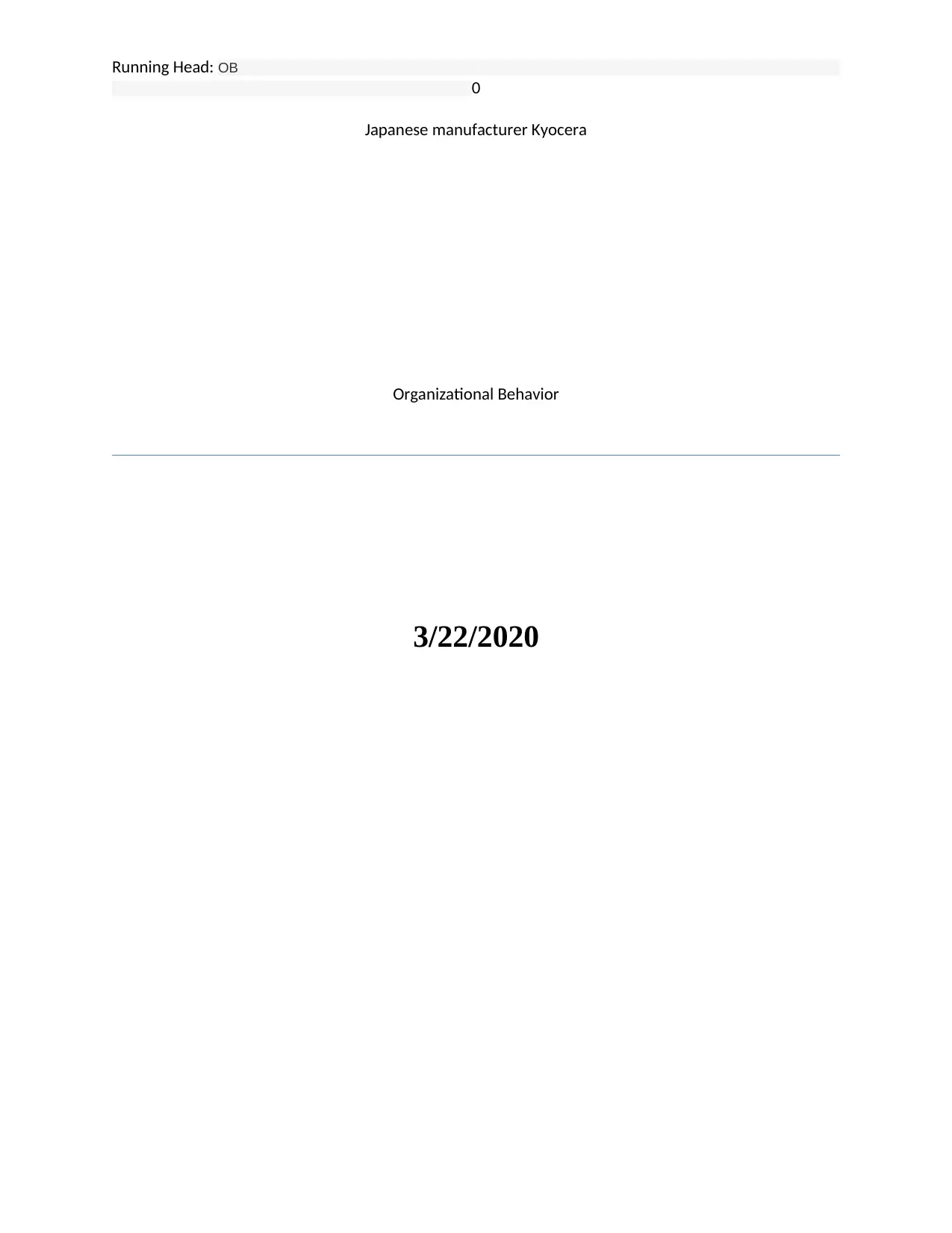
Running Head: OB
0
Japanese manufacturer Kyocera
Organizational Behavior
3/22/2020
0
Japanese manufacturer Kyocera
Organizational Behavior
3/22/2020
Paraphrase This Document
Need a fresh take? Get an instant paraphrase of this document with our AI Paraphraser
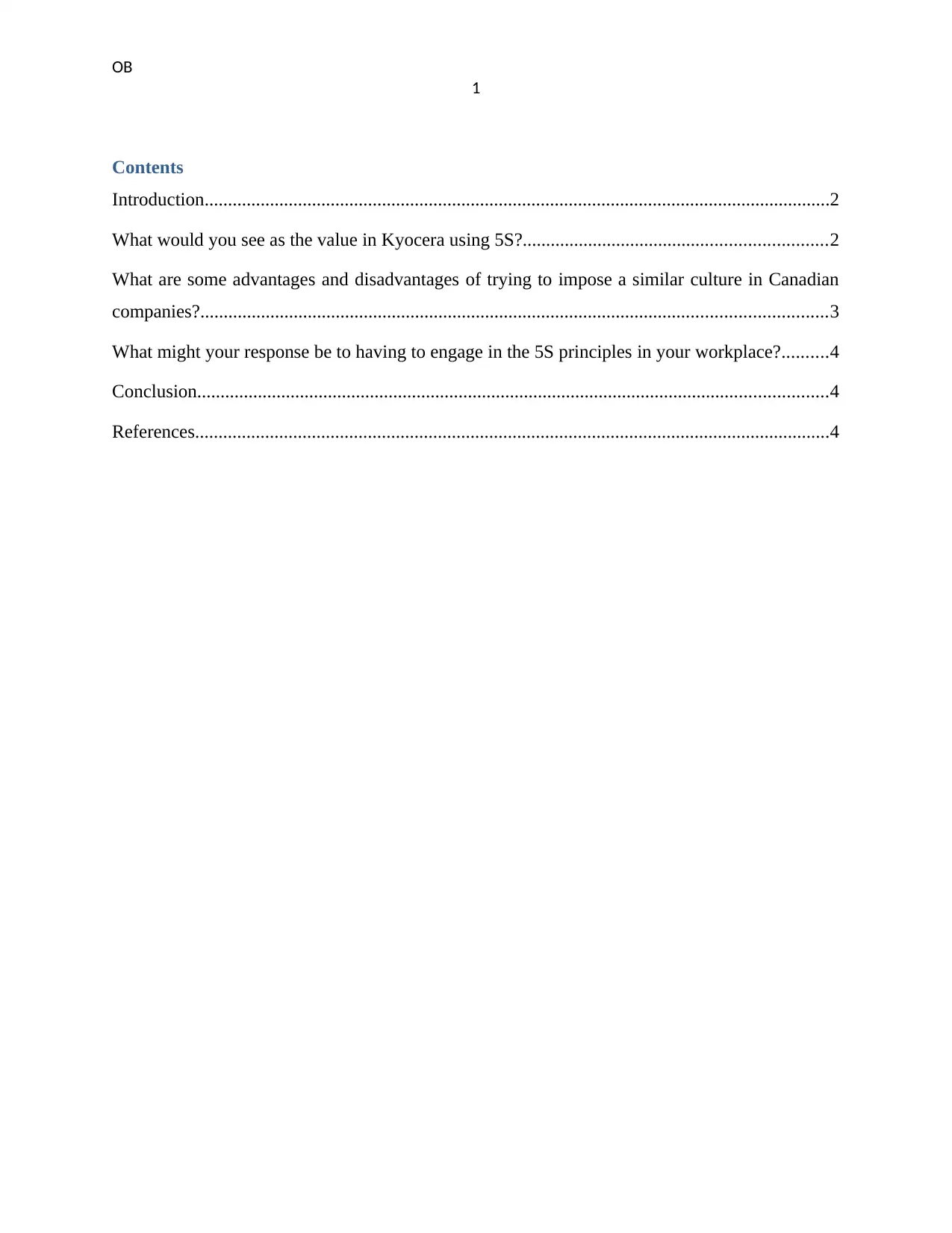
OB
1
Contents
Introduction......................................................................................................................................2
What would you see as the value in Kyocera using 5S?.................................................................2
What are some advantages and disadvantages of trying to impose a similar culture in Canadian
companies?......................................................................................................................................3
What might your response be to having to engage in the 5S principles in your workplace?..........4
Conclusion.......................................................................................................................................4
References........................................................................................................................................4
1
Contents
Introduction......................................................................................................................................2
What would you see as the value in Kyocera using 5S?.................................................................2
What are some advantages and disadvantages of trying to impose a similar culture in Canadian
companies?......................................................................................................................................3
What might your response be to having to engage in the 5S principles in your workplace?..........4
Conclusion.......................................................................................................................................4
References........................................................................................................................................4
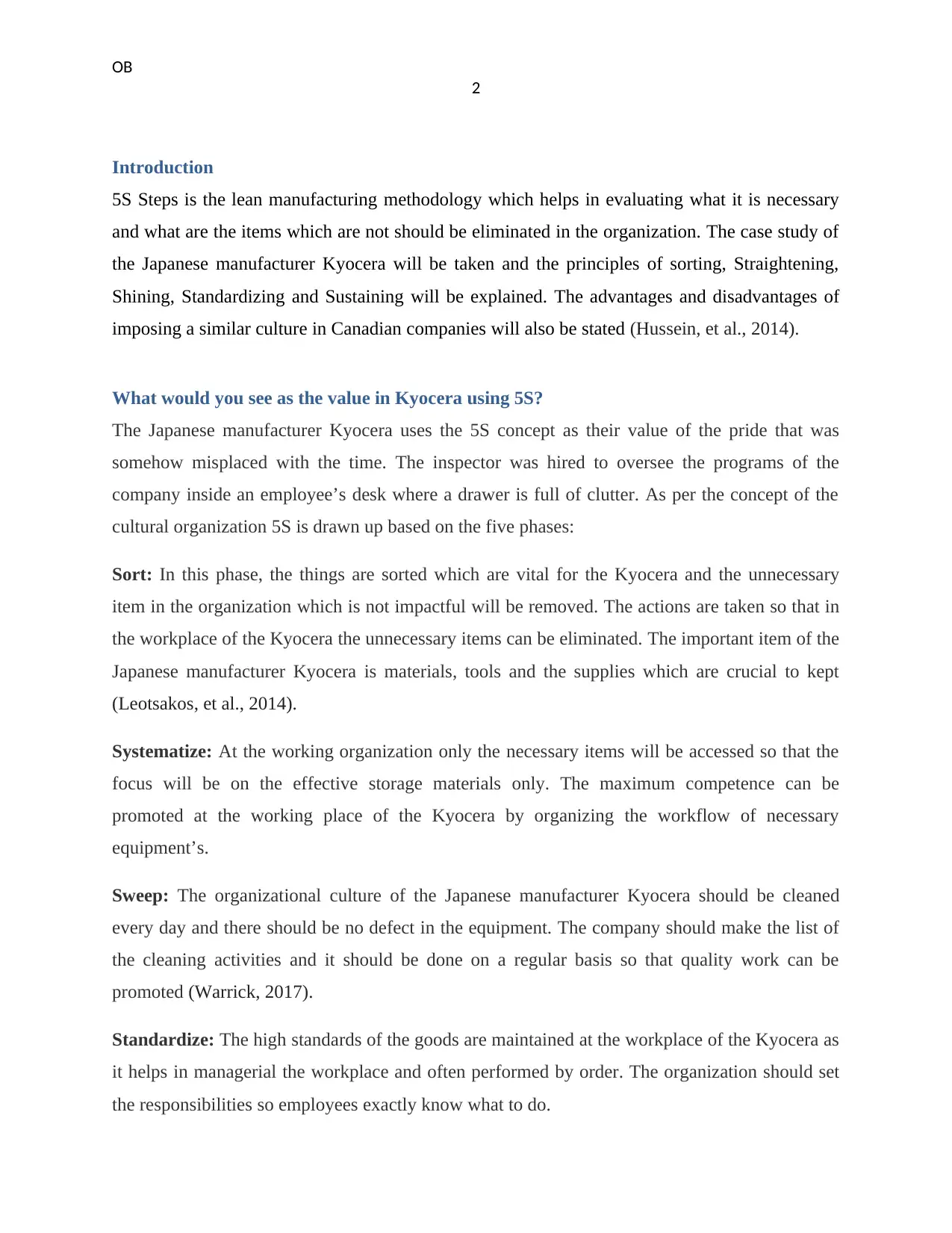
OB
2
Introduction
5S Steps is the lean manufacturing methodology which helps in evaluating what it is necessary
and what are the items which are not should be eliminated in the organization. The case study of
the Japanese manufacturer Kyocera will be taken and the principles of sorting, Straightening,
Shining, Standardizing and Sustaining will be explained. The advantages and disadvantages of
imposing a similar culture in Canadian companies will also be stated (Hussein, et al., 2014).
What would you see as the value in Kyocera using 5S?
The Japanese manufacturer Kyocera uses the 5S concept as their value of the pride that was
somehow misplaced with the time. The inspector was hired to oversee the programs of the
company inside an employee’s desk where a drawer is full of clutter. As per the concept of the
cultural organization 5S is drawn up based on the five phases:
Sort: In this phase, the things are sorted which are vital for the Kyocera and the unnecessary
item in the organization which is not impactful will be removed. The actions are taken so that in
the workplace of the Kyocera the unnecessary items can be eliminated. The important item of the
Japanese manufacturer Kyocera is materials, tools and the supplies which are crucial to kept
(Leotsakos, et al., 2014).
Systematize: At the working organization only the necessary items will be accessed so that the
focus will be on the effective storage materials only. The maximum competence can be
promoted at the working place of the Kyocera by organizing the workflow of necessary
equipment’s.
Sweep: The organizational culture of the Japanese manufacturer Kyocera should be cleaned
every day and there should be no defect in the equipment. The company should make the list of
the cleaning activities and it should be done on a regular basis so that quality work can be
promoted (Warrick, 2017).
Standardize: The high standards of the goods are maintained at the workplace of the Kyocera as
it helps in managerial the workplace and often performed by order. The organization should set
the responsibilities so employees exactly know what to do.
2
Introduction
5S Steps is the lean manufacturing methodology which helps in evaluating what it is necessary
and what are the items which are not should be eliminated in the organization. The case study of
the Japanese manufacturer Kyocera will be taken and the principles of sorting, Straightening,
Shining, Standardizing and Sustaining will be explained. The advantages and disadvantages of
imposing a similar culture in Canadian companies will also be stated (Hussein, et al., 2014).
What would you see as the value in Kyocera using 5S?
The Japanese manufacturer Kyocera uses the 5S concept as their value of the pride that was
somehow misplaced with the time. The inspector was hired to oversee the programs of the
company inside an employee’s desk where a drawer is full of clutter. As per the concept of the
cultural organization 5S is drawn up based on the five phases:
Sort: In this phase, the things are sorted which are vital for the Kyocera and the unnecessary
item in the organization which is not impactful will be removed. The actions are taken so that in
the workplace of the Kyocera the unnecessary items can be eliminated. The important item of the
Japanese manufacturer Kyocera is materials, tools and the supplies which are crucial to kept
(Leotsakos, et al., 2014).
Systematize: At the working organization only the necessary items will be accessed so that the
focus will be on the effective storage materials only. The maximum competence can be
promoted at the working place of the Kyocera by organizing the workflow of necessary
equipment’s.
Sweep: The organizational culture of the Japanese manufacturer Kyocera should be cleaned
every day and there should be no defect in the equipment. The company should make the list of
the cleaning activities and it should be done on a regular basis so that quality work can be
promoted (Warrick, 2017).
Standardize: The high standards of the goods are maintained at the workplace of the Kyocera as
it helps in managerial the workplace and often performed by order. The organization should set
the responsibilities so employees exactly know what to do.
⊘ This is a preview!⊘
Do you want full access?
Subscribe today to unlock all pages.

Trusted by 1+ million students worldwide
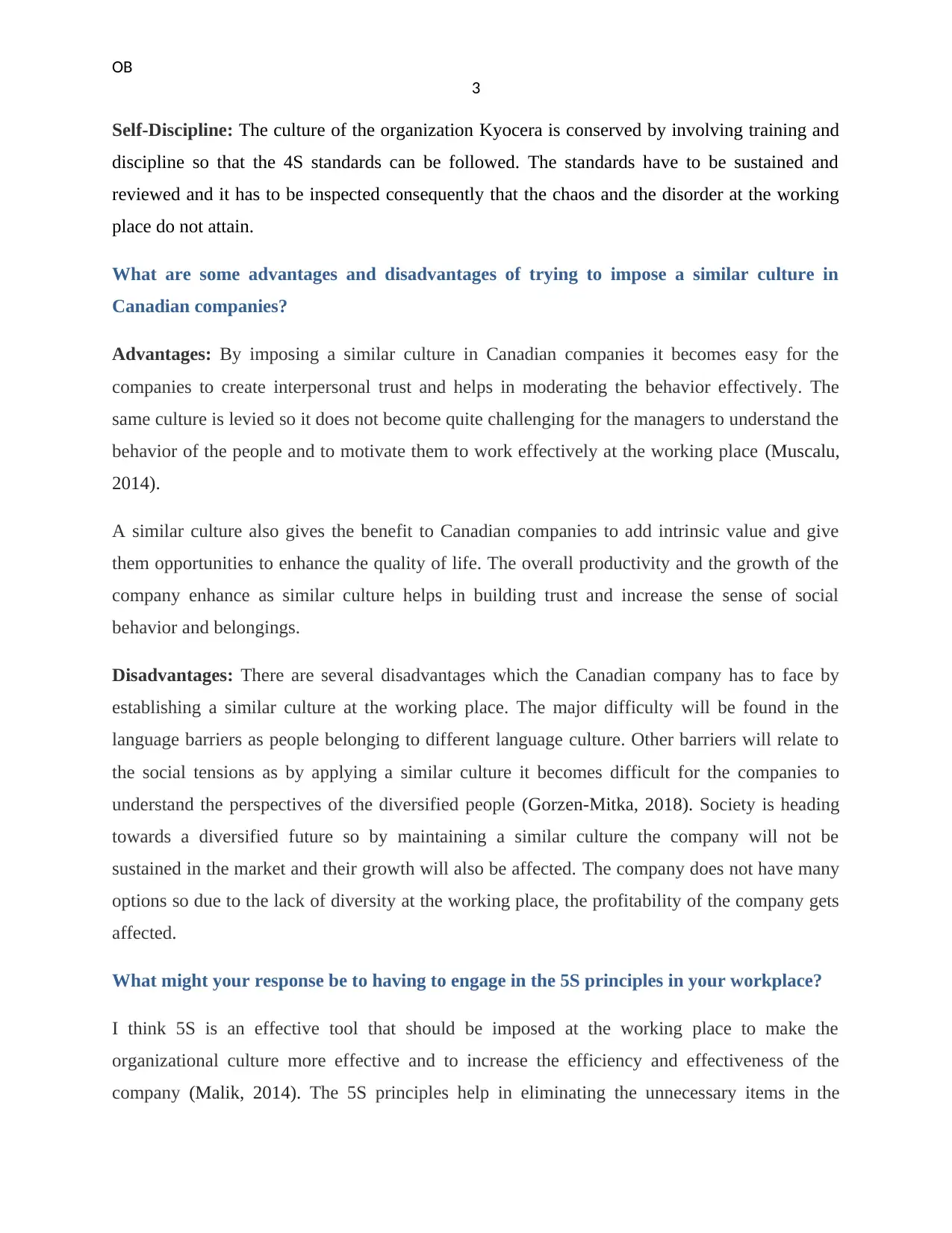
OB
3
Self-Discipline: The culture of the organization Kyocera is conserved by involving training and
discipline so that the 4S standards can be followed. The standards have to be sustained and
reviewed and it has to be inspected consequently that the chaos and the disorder at the working
place do not attain.
What are some advantages and disadvantages of trying to impose a similar culture in
Canadian companies?
Advantages: By imposing a similar culture in Canadian companies it becomes easy for the
companies to create interpersonal trust and helps in moderating the behavior effectively. The
same culture is levied so it does not become quite challenging for the managers to understand the
behavior of the people and to motivate them to work effectively at the working place (Muscalu,
2014).
A similar culture also gives the benefit to Canadian companies to add intrinsic value and give
them opportunities to enhance the quality of life. The overall productivity and the growth of the
company enhance as similar culture helps in building trust and increase the sense of social
behavior and belongings.
Disadvantages: There are several disadvantages which the Canadian company has to face by
establishing a similar culture at the working place. The major difficulty will be found in the
language barriers as people belonging to different language culture. Other barriers will relate to
the social tensions as by applying a similar culture it becomes difficult for the companies to
understand the perspectives of the diversified people (Gorzen-Mitka, 2018). Society is heading
towards a diversified future so by maintaining a similar culture the company will not be
sustained in the market and their growth will also be affected. The company does not have many
options so due to the lack of diversity at the working place, the profitability of the company gets
affected.
What might your response be to having to engage in the 5S principles in your workplace?
I think 5S is an effective tool that should be imposed at the working place to make the
organizational culture more effective and to increase the efficiency and effectiveness of the
company (Malik, 2014). The 5S principles help in eliminating the unnecessary items in the
3
Self-Discipline: The culture of the organization Kyocera is conserved by involving training and
discipline so that the 4S standards can be followed. The standards have to be sustained and
reviewed and it has to be inspected consequently that the chaos and the disorder at the working
place do not attain.
What are some advantages and disadvantages of trying to impose a similar culture in
Canadian companies?
Advantages: By imposing a similar culture in Canadian companies it becomes easy for the
companies to create interpersonal trust and helps in moderating the behavior effectively. The
same culture is levied so it does not become quite challenging for the managers to understand the
behavior of the people and to motivate them to work effectively at the working place (Muscalu,
2014).
A similar culture also gives the benefit to Canadian companies to add intrinsic value and give
them opportunities to enhance the quality of life. The overall productivity and the growth of the
company enhance as similar culture helps in building trust and increase the sense of social
behavior and belongings.
Disadvantages: There are several disadvantages which the Canadian company has to face by
establishing a similar culture at the working place. The major difficulty will be found in the
language barriers as people belonging to different language culture. Other barriers will relate to
the social tensions as by applying a similar culture it becomes difficult for the companies to
understand the perspectives of the diversified people (Gorzen-Mitka, 2018). Society is heading
towards a diversified future so by maintaining a similar culture the company will not be
sustained in the market and their growth will also be affected. The company does not have many
options so due to the lack of diversity at the working place, the profitability of the company gets
affected.
What might your response be to having to engage in the 5S principles in your workplace?
I think 5S is an effective tool that should be imposed at the working place to make the
organizational culture more effective and to increase the efficiency and effectiveness of the
company (Malik, 2014). The 5S principles help in eliminating the unnecessary items in the
Paraphrase This Document
Need a fresh take? Get an instant paraphrase of this document with our AI Paraphraser
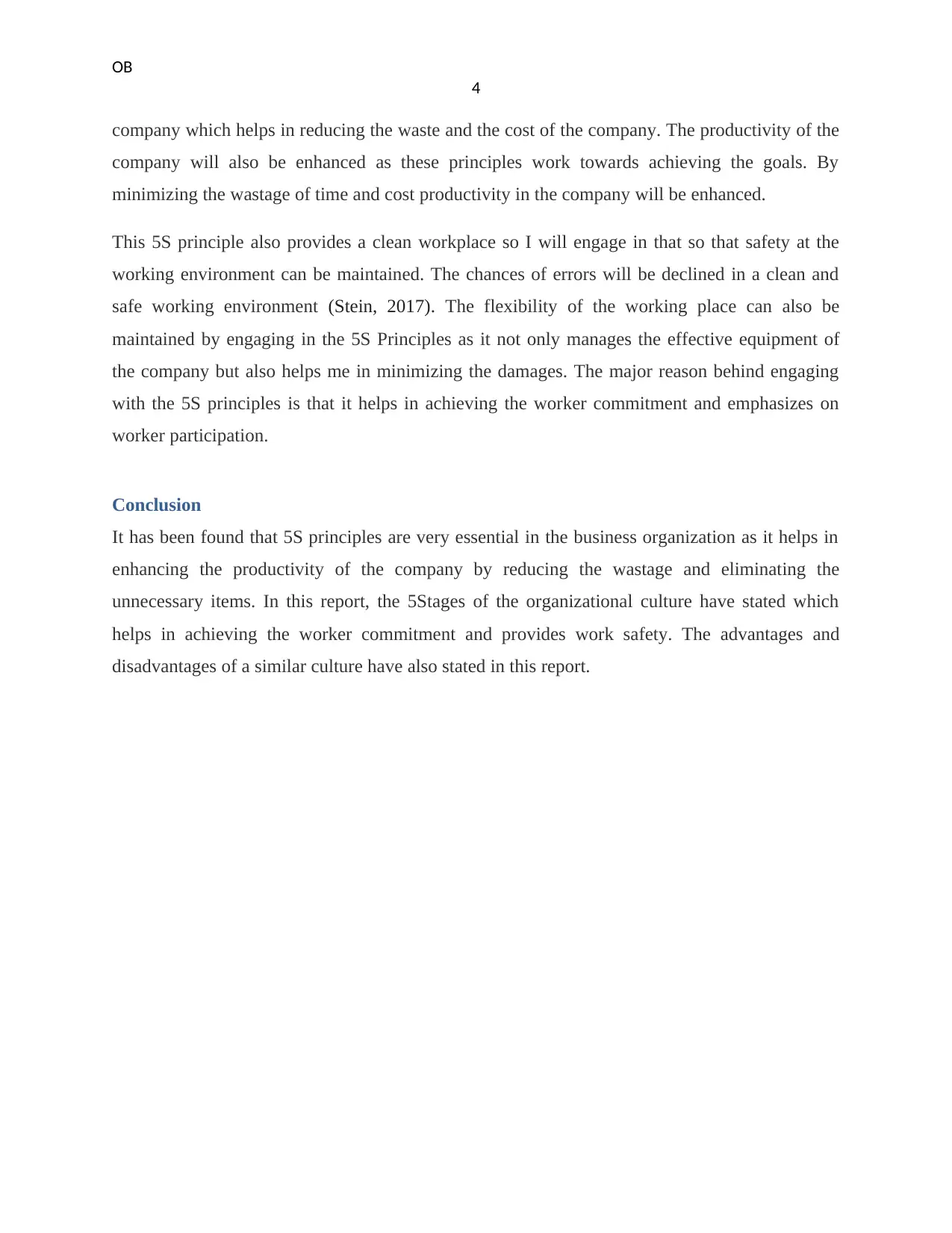
OB
4
company which helps in reducing the waste and the cost of the company. The productivity of the
company will also be enhanced as these principles work towards achieving the goals. By
minimizing the wastage of time and cost productivity in the company will be enhanced.
This 5S principle also provides a clean workplace so I will engage in that so that safety at the
working environment can be maintained. The chances of errors will be declined in a clean and
safe working environment (Stein, 2017). The flexibility of the working place can also be
maintained by engaging in the 5S Principles as it not only manages the effective equipment of
the company but also helps me in minimizing the damages. The major reason behind engaging
with the 5S principles is that it helps in achieving the worker commitment and emphasizes on
worker participation.
Conclusion
It has been found that 5S principles are very essential in the business organization as it helps in
enhancing the productivity of the company by reducing the wastage and eliminating the
unnecessary items. In this report, the 5Stages of the organizational culture have stated which
helps in achieving the worker commitment and provides work safety. The advantages and
disadvantages of a similar culture have also stated in this report.
4
company which helps in reducing the waste and the cost of the company. The productivity of the
company will also be enhanced as these principles work towards achieving the goals. By
minimizing the wastage of time and cost productivity in the company will be enhanced.
This 5S principle also provides a clean workplace so I will engage in that so that safety at the
working environment can be maintained. The chances of errors will be declined in a clean and
safe working environment (Stein, 2017). The flexibility of the working place can also be
maintained by engaging in the 5S Principles as it not only manages the effective equipment of
the company but also helps me in minimizing the damages. The major reason behind engaging
with the 5S principles is that it helps in achieving the worker commitment and emphasizes on
worker participation.
Conclusion
It has been found that 5S principles are very essential in the business organization as it helps in
enhancing the productivity of the company by reducing the wastage and eliminating the
unnecessary items. In this report, the 5Stages of the organizational culture have stated which
helps in achieving the worker commitment and provides work safety. The advantages and
disadvantages of a similar culture have also stated in this report.
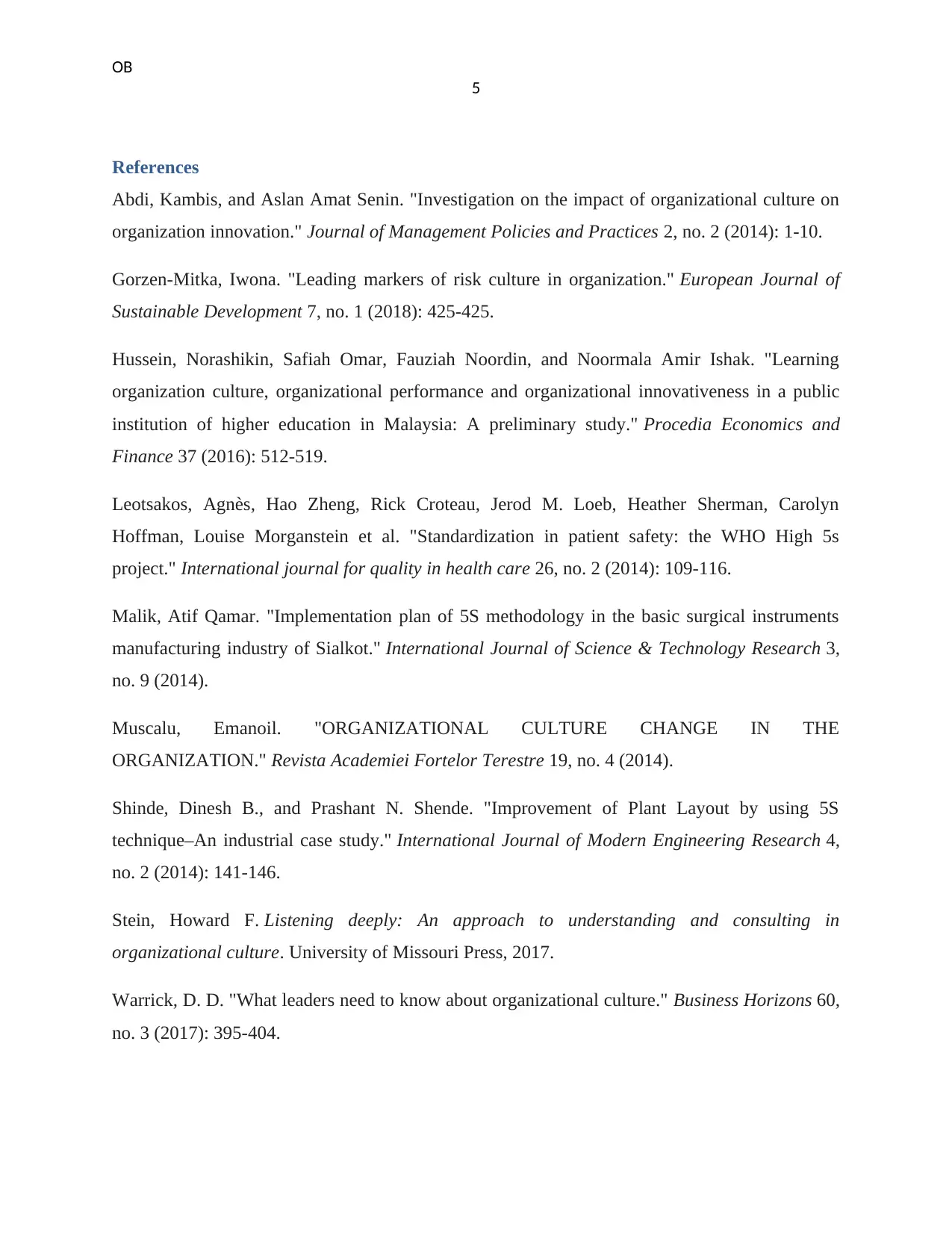
OB
5
References
Abdi, Kambis, and Aslan Amat Senin. "Investigation on the impact of organizational culture on
organization innovation." Journal of Management Policies and Practices 2, no. 2 (2014): 1-10.
Gorzen-Mitka, Iwona. "Leading markers of risk culture in organization." European Journal of
Sustainable Development 7, no. 1 (2018): 425-425.
Hussein, Norashikin, Safiah Omar, Fauziah Noordin, and Noormala Amir Ishak. "Learning
organization culture, organizational performance and organizational innovativeness in a public
institution of higher education in Malaysia: A preliminary study." Procedia Economics and
Finance 37 (2016): 512-519.
Leotsakos, Agnès, Hao Zheng, Rick Croteau, Jerod M. Loeb, Heather Sherman, Carolyn
Hoffman, Louise Morganstein et al. "Standardization in patient safety: the WHO High 5s
project." International journal for quality in health care 26, no. 2 (2014): 109-116.
Malik, Atif Qamar. "Implementation plan of 5S methodology in the basic surgical instruments
manufacturing industry of Sialkot." International Journal of Science & Technology Research 3,
no. 9 (2014).
Muscalu, Emanoil. "ORGANIZATIONAL CULTURE CHANGE IN THE
ORGANIZATION." Revista Academiei Fortelor Terestre 19, no. 4 (2014).
Shinde, Dinesh B., and Prashant N. Shende. "Improvement of Plant Layout by using 5S
technique–An industrial case study." International Journal of Modern Engineering Research 4,
no. 2 (2014): 141-146.
Stein, Howard F. Listening deeply: An approach to understanding and consulting in
organizational culture. University of Missouri Press, 2017.
Warrick, D. D. "What leaders need to know about organizational culture." Business Horizons 60,
no. 3 (2017): 395-404.
5
References
Abdi, Kambis, and Aslan Amat Senin. "Investigation on the impact of organizational culture on
organization innovation." Journal of Management Policies and Practices 2, no. 2 (2014): 1-10.
Gorzen-Mitka, Iwona. "Leading markers of risk culture in organization." European Journal of
Sustainable Development 7, no. 1 (2018): 425-425.
Hussein, Norashikin, Safiah Omar, Fauziah Noordin, and Noormala Amir Ishak. "Learning
organization culture, organizational performance and organizational innovativeness in a public
institution of higher education in Malaysia: A preliminary study." Procedia Economics and
Finance 37 (2016): 512-519.
Leotsakos, Agnès, Hao Zheng, Rick Croteau, Jerod M. Loeb, Heather Sherman, Carolyn
Hoffman, Louise Morganstein et al. "Standardization in patient safety: the WHO High 5s
project." International journal for quality in health care 26, no. 2 (2014): 109-116.
Malik, Atif Qamar. "Implementation plan of 5S methodology in the basic surgical instruments
manufacturing industry of Sialkot." International Journal of Science & Technology Research 3,
no. 9 (2014).
Muscalu, Emanoil. "ORGANIZATIONAL CULTURE CHANGE IN THE
ORGANIZATION." Revista Academiei Fortelor Terestre 19, no. 4 (2014).
Shinde, Dinesh B., and Prashant N. Shende. "Improvement of Plant Layout by using 5S
technique–An industrial case study." International Journal of Modern Engineering Research 4,
no. 2 (2014): 141-146.
Stein, Howard F. Listening deeply: An approach to understanding and consulting in
organizational culture. University of Missouri Press, 2017.
Warrick, D. D. "What leaders need to know about organizational culture." Business Horizons 60,
no. 3 (2017): 395-404.
⊘ This is a preview!⊘
Do you want full access?
Subscribe today to unlock all pages.

Trusted by 1+ million students worldwide
1 out of 6
Your All-in-One AI-Powered Toolkit for Academic Success.
+13062052269
info@desklib.com
Available 24*7 on WhatsApp / Email
![[object Object]](/_next/static/media/star-bottom.7253800d.svg)
Unlock your academic potential
Copyright © 2020–2025 A2Z Services. All Rights Reserved. Developed and managed by ZUCOL.